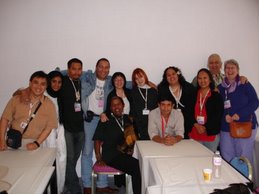The issue of land ownership in Bolivia is a long-standing source of conflict and division. Over the past few years however, the situation has been changing for the better largely because of the determination of the indigenous peoples themselves who have enlisted the latest technology to help them overcome the bureaucratic obstacles that have prevented land transfers from taking place.
By 2001 after 11 years of land titling in Bolivia's lowlands, only one percent of land claims by indigenous peoples had been settled. Eliana Rioja, responsible for the communications programme of the Confederation of Indigenous Peoples of Bolivia (CIDOB) explains: "The slow progress in land titling we attributed to the reluctance of the agrarian reform institute (INRA) officials to move claims forward. They kept on coming up with confusing information or requesting technical information that was already available. Basically most of them were close to the large landowning interests." The CIDOB decided to take action to accelerate this process.
In 2001 CIDOB launched its internet land titling project, which consisted of building up a database of all land claims, systematically updating their progress, and setting out clearly the procedures for settlement.
Community leaders were taught to use computers, navigate the Internet and then understand the databases created to assist land claims. Now, dozens of blogs and community activities, accessible through the CIDOB webpage, are run mainly by indigenous women.
The result of this technical revolution in the indigenous communities has been a huge increase in the number of successful land claims. Since the community 'logged on' in 2001 half of the claims have been settled. The indigenous peoples of the lowlands now have ownership of 10 million hectares of land.
CIDOB has trained 250 communications volunteers throughout the Bolivian lowlands, an area which covers 34 different indigenous groups, most of them with their own languages. These communities live from farming, fishing and hunting. Some of these peoples live in remote lands that are only accessible on foot or by river.
CIDOB is giving a great push also to other areas of communication. More than 300 videos were produced and the film "El grito de la selva" ("The shout of the forest"), which has an archive of some 100 radio interviews and thousands of photographs, won an international prize in 2008.
The UN human rights office in Bolivia recently shared this story in a workshop held in Santa Cruz, Bolivia's largest city. The Office presented information about the Declaration on the Rights of Indigenous Peoples and the Expert Mechanism on the Rights of Indigenous Peoples. The Bolivia Office expects the information to reach hundreds of indigenous communities, including those in the lowlands, so that they can take more action for their rights.
Source: Office of the High Commissioner for Human Rights
By 2001 after 11 years of land titling in Bolivia's lowlands, only one percent of land claims by indigenous peoples had been settled. Eliana Rioja, responsible for the communications programme of the Confederation of Indigenous Peoples of Bolivia (CIDOB) explains: "The slow progress in land titling we attributed to the reluctance of the agrarian reform institute (INRA) officials to move claims forward. They kept on coming up with confusing information or requesting technical information that was already available. Basically most of them were close to the large landowning interests." The CIDOB decided to take action to accelerate this process.
In 2001 CIDOB launched its internet land titling project, which consisted of building up a database of all land claims, systematically updating their progress, and setting out clearly the procedures for settlement.
Community leaders were taught to use computers, navigate the Internet and then understand the databases created to assist land claims. Now, dozens of blogs and community activities, accessible through the CIDOB webpage, are run mainly by indigenous women.
The result of this technical revolution in the indigenous communities has been a huge increase in the number of successful land claims. Since the community 'logged on' in 2001 half of the claims have been settled. The indigenous peoples of the lowlands now have ownership of 10 million hectares of land.
CIDOB has trained 250 communications volunteers throughout the Bolivian lowlands, an area which covers 34 different indigenous groups, most of them with their own languages. These communities live from farming, fishing and hunting. Some of these peoples live in remote lands that are only accessible on foot or by river.
CIDOB is giving a great push also to other areas of communication. More than 300 videos were produced and the film "El grito de la selva" ("The shout of the forest"), which has an archive of some 100 radio interviews and thousands of photographs, won an international prize in 2008.
The UN human rights office in Bolivia recently shared this story in a workshop held in Santa Cruz, Bolivia's largest city. The Office presented information about the Declaration on the Rights of Indigenous Peoples and the Expert Mechanism on the Rights of Indigenous Peoples. The Bolivia Office expects the information to reach hundreds of indigenous communities, including those in the lowlands, so that they can take more action for their rights.
Source: Office of the High Commissioner for Human Rights



No comments:
Post a Comment